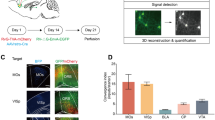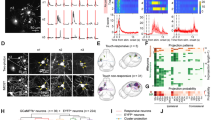Summary
Intracellular recordings were obtained from 204 neurones in the lateral reticular nucleus (LRN). LRN neurones contacted by the bVFRT were identified by the responses evoked on stimulation of descending fibres in the contralateral ventral quadrant of the spinal cord (cVQ) at cervical (C5cVQ) and lumbar (L2cVQ) levels. Stimulation of the cVQ evoked excitatory or inhibitory responses in 124 of the 204 LRN neurones. EPSPs were evoked in 45, IPSPs in 52 and both EPSPs and IPSPs in 27 LRN neurones. The shortest latencies of the responses evoked from the cVQ indicated that both EPSPs and IPSPs were disynaptic. This finding was confirmed by direct stimulation of the ascending fibres in the ipsilateral ventrolateral funiculus at C3 (C3iVLF) or LI (LliVLF). In most LRN neurones activated or inhibited from the cVQ, stimulation of the iVLF evoked similar responses at a monosynaptic latency. These results indicate that the bVFRT consists of roughly equally large groups of excitatory and inhibitory neurones monosynaptically connected with the LRN. Excitatory and inhibitory bVFRT neurones had similar peripheral receptive fields and termination areas in the LRN. LRN neurones were divided into those contacted by cervical bVFRT neurones and lumbar bVFRT neurones. The former group consisted of LRN neurones responding to C5cVQ stimulation at latencies below 5 ms, whereas the latter group contained LRN neurones responding to stimulation of the L2cVQ. Cervical bVFRT neurones projected to most parts of the LRN whereas the projection of lumbar bVFRT neurones were confined to the ventrolateral part of the nucleus. Excitatory and inhibitory bVFRT neurones of each group had similar termination areas. About half of the LRN neurones contacted by cervical bVFRT neurones did not respond to stimulation of the contralateral forelimb (cF) nerve. These bVFRT neurones formed a separate group which terminated in the dorsomedial part of the LRN. Cervical bVFRT neurones activated by the cF terminated in the ventrolateral part of the nucleus. The conduction velocity between the L1 and C3 segments was determined for axons of lumbar bVFRT neurones. The velocities ranged between 55–137 m/s (mean 90.6 m/s) for excitatory neurones and between 35–120 (mean 87.5 m/s) for inhibitory neurones. Monosynaptic responses, particularly EPSPs, were frequently evoked from the L1iVLF in LRN neurones with a bVFRT input from cervical segments only. The results suggest that many excitatory cervical bVFRT neurones have fast conducting descending axon branches projecting to the lumber cord. Long descending axon branches seemed to be less common among inhibitory cervical bVFRT neurones.
Similar content being viewed by others
References
Akaike T (1973) Comparison of neuronal composition of the vestibulospinal system between cat and rabbit. Exp Brain Res 18: 429–432
Alstermark B, Lindström S, Lundberg A, Sybirska E (1981a) Integration in descending motor pathways controlling the forelimb in the cat. 8. Ascending projection to the lateral reticular nucleus from C3–C4 propriospinal neurones also projecting to forelimb motoneurones. Exp Brain Res 42: 282–298
Alstermark B, Lundberg A, Norsell U, Sybirska E (1981b) Integration in descending motor pathways controlling the forelimb in the cat. 9. Differential behavioral defects after spinal cord lesions interrupting defined pathways from higher motor centres to motoneurones. Exp Brain Res 42: 299–318
Alstermark B, Lundberg A, Sasaki S (1984) Integration in descending motor pathways controlling the forelimb in the cat. 11. Inhibitory pathways from higher motor centres and forelimb afferents to C3–C4 propriospinal neurones. Exp Brain Res 56: 293–307
Arshavsky YI, Gelfand IM, Orlovsky GN, Pavlova GA (1978) Messages conveyed by spinocerebellar pathways during scratching in the cat. I. Activity of neurones of the lateral reticular nucleus. Brain Res 151: 493–506
Clendenin M, Ekerot C -F, Oscarsson O, Rosén I (1974a) The lateral reticular nucleus in the cat. I. Mossy fibre distribution in cerebellar cortex. Exp Brain Res 21: 473–486
Clendenin M, Ekerot C -F, Oscarsson O, Rosén I (1974b) The lateral reticular nucleus in the cat. II. Organization of component activated from bilateral ventral fexor reflex tract (bVFRT). Exp Brain Res 21: 487–500
Clendenin M, Ekerot C -F, Oscarsson O (1974c) The lateral reticular nucleus in the cat. III. Organization of component activated from the ipsilateral forelimb tract. Exp Brain Res 21: 501–513
Ekerot C -F (1978) Information mediated by the lateral reticular nucleus. Neurosci Lett [Suppl] 1: 414
Ekerot C-F (1989a) The lateral reticular nucleus in the cat. VI. Excitatory and inhibitory afferent paths. Exp Brain Res 79: 109–119
Ekerot C-F (1989b) The lateral reticular nucleus in the cat. VII. Excitatory and inhibitory projection from the ipsilateral forelimb tract (iF tract). Exp Brain Res 79: 120–128
Ekerot C-F, Oscarsson O (1975) Inhibitory spinal paths to the lateral reticular nucleus. Brain Res 99: 157–161
Grant G, Oscarsson O, Rosén I (1966) Functional organization of the spinoreticulocerebellar path with identification of its spinal component. Exp Brain Res 1: 306–319
Holmqvist B, Lundberg A, Oscarsson O (1960) A supraspinal control system monosynaptically connected with an ascending spinal pathway. Arch Ital Biol 98: 402–422
Hongo T, Kudo N, Tanaka R (1975) The vestibulospinal tract: crossed and uncrossed effects on hindlimb motoneurones in the cat. Exp Brain Res 24: 37–55
Illert M, Lundberg A (1978) Collateral connections to the lateral reticular nucleus from cervical proprio-spinal neurones projecting to forelimb motoneurones in the cat. Neurosci Lett 7: 167–172
Künzle H (1973) The topographic organization of spinal afferents to the lateral reticular nucleus of the cat. J Comp Neurol 149: 103–116
Lundberg A, Oscarsson O (1962) Two ascending spinal pathways in the ventral part of the cord. Acta Physiol Scand 54: 270–286
Oscarsson O (1958) Further observations on ascending spinal tracts activated from muscle, joint, and skin nerves. Arch Ital Biol 96: 199–215
Oscarsson O, Rosén I (1966) Response characteristics of reticulocerebellar neurones activated from spinal afferents. Exp Brain Res 1: 320–328
Rosén I, Scheid P (1973a) Patterns of afferent input to the lateral reticular nucleus of the cat. Exp Brain Res 18: 242–255
Rosén I, Scheid P (1973b) Responses to nerve stimulation in the bilateral ventral flexor reflex tract (bVFRT) of the cat. Exp Brain Res 18: 256–267
Author information
Authors and Affiliations
Rights and permissions
About this article
Cite this article
Ekerot, C.F. The lateral reticular nucleus in the cat. Exp Brain Res 79, 129–137 (1990). https://doi.org/10.1007/BF00228881
Received:
Accepted:
Issue Date:
DOI: https://doi.org/10.1007/BF00228881




